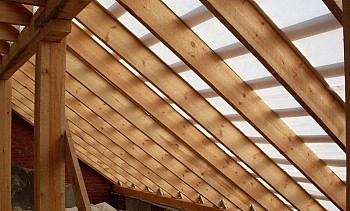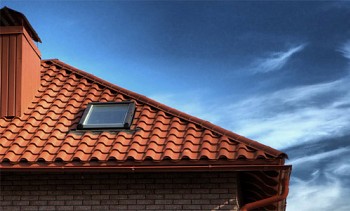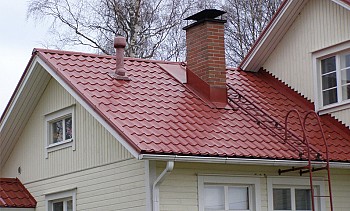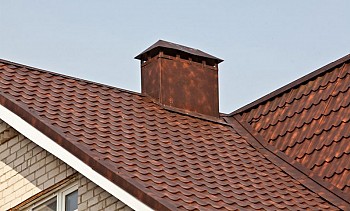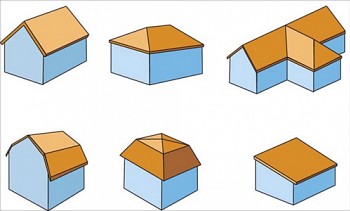When choosing a roof, the owner of a future private house often chooses an inexpensive option with two slopes. The practical and uncomplicated design of such a roof is reliable, durable and provides good protection from the weather. Let's consider how the rafter system of a gable roof is arranged - the most important element of its design.
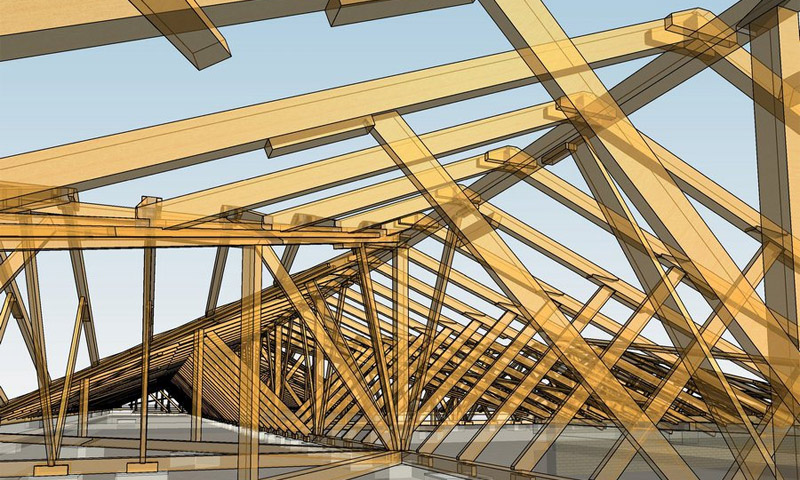
Content:
On a gable roof in a nutshell
A gable roof is called a roof in which two rectangular flat slopes are connected at an angle above. At the same time, triangular openings remain on the sides. Gables are inserted there. In order for the structure to be strong, reliable and serve for a long time, various retaining and supporting elements are used in it. The most important of them is the rafter system of the gable roof, to which, in fact, this material is dedicated.
Structural elements of gable roofs
In general, all these elements of gable roofs are boards, beams and beams of various lengths, shapes and sections. Let's consider them all in order.
Mauerlat
This is a coniferous square beam, the size of which is usually 10 or 15 centimeters. It is laid along each of the bearing walls, attaching to them with rods on the thread or anchors. The purpose of this element is to uniformly transfer the load from the legs of the rafters to the supporting walls.
Rafter leg
This is a beam, in the context of measuring 15 centimeters by 5 (or 10) centimeters. It is from these elements that our triangular contour of the roof is assembled, which carries the whole burden of wind, hail, snow and other weather vicissitudes. To adequately withstand these loads, the rafters are positioned in increments of 0.6 to 1.2 meters. The more weighty the roof is assumed, the smaller this distance. In addition, the rafter pitch, in some cases, will depend on the design features of the roofing used.
Sill
The square beam for this element has the same cross section as for the Mauerlat - 10/10 or 15/15 centimeters. It is horizontally placed on the inner load-bearing wall in order to evenly distribute the load from the roof racks.
Puff
This element is used for hanging rafter system. He completes the triangle of rafter legs, not allowing him to creep.
Racks
The bar for them is taken square, the same as for the previous element. Racks are placed vertically, taking on the load from the ridge and passing it to the load-bearing wall inside the house.
Struts
These elements act as a transmission link between the legs of the rafters and the supporting elements. Combining the puff and struts, they get a farm - a very strong element. Even with a large span, the farm will endure all the loads.
Crate
Perpendicular to the legs of the rafters, the bars (or boards) of the crate are laid. Passing the entire weight of the roof to the rafter legs, this structural element additionally holds them together. It is preferable to equip the lathing with edged bars or boards. But for want of a better board, unedged boards will also work - but with the bark removed. Well, and in the case of soft roofing (for example, shingles on a bitumen basis), the crate is made continuous. To do this, take moisture-resistant plywood sheets.

Skate roof
The ridge is the top place of the roof connecting the two slopes of the roof. It is formed by connecting the rafters in the upper part of the roof. It is located horizontally.
Eaves
This element, protruding from the walls at a distance of about 40 centimeters, prevents rainwater from wetting these walls.
Mares
And again the "horse" name. These structural elements of the rafter system of the gable roof are needed to organize the roof overhang. The need for them appears only when the rafters are too short, and they are not enough for the overhang. Then these legs are lengthened with mares, which are boards of somewhat smaller cross section.

Types of roof systems of gable roofs
There are only two of these systems: the hanging type and the layered type. The former are used when the outer walls of the house are 10 meters or less apart. There is one more condition - between these walls there should not be a wall of the bearing type, dividing the house in two. Otherwise, it is necessary to use layered rafters. When the house under construction is not divided by a supporting wall, but by columns, two rafter systems are mounted at once. The rafters, located at an angle, will rest on the columns, and the hanging ones will fit perfectly between them.
Hanging rafter system
For this scheme of the rafter system of a gable roof, it is characteristic that the rafters rest on the side walls. The bad news is that this creates a bursting load that can damage the walls over time. To prevent this from happening, the legs of the rafters are connected by a puff. As a result, a rigid triangle is formed that is not subject to deformation under loads. Often, instead of puffs, floor beams are used, this is especially true when it is necessary to equip the attic room under the roof.
The advantage of this system is that it is not necessary to mount the Mauerlat at all. In addition, those parts of the structure where the rafters rest on the walls are quite simply mounted. The board laid through the insulation layer will help to make the truss smooth and stable, providing a large area of support. Next, we consider the main varieties of hanging rafters. They are all three-jointed.
#1. A simple triangular hinged arch.
This is the most simple structure, which is a closed triangle, the two upper sides of which are subjected to bending stress. Tightening in this design does not work only in tension and is not a supporting structure, so it can be replaced with a steel band.

There are several solutions for organizing the design of the cornice assembly. These are orthogonal frontal cuttings, as well as the use of board or plate mounts.

#2. A triangular hinged arch reinforced with a headstock or pendant.
This option was used only earlier, building large industrial or agricultural premises with a span of more than 6 meters. For private homes, this scheme is not suitable. Its principle is that the weight of the puff (made up of individual short elements) takes on the skate. These elements are connected to each other and to the suspension bracket with the help of a cut (oblique or direct). Bolts are used for fastening. A wooden pendant is called a grandmother, and an iron pendant is called a heavy. This part is hanging on the ledge assembly, and the puff is attached to its lower part through wooden lining. Adapters are clamps that control the deflection of the puff if it sags.

#3. Triangular hinged arch with a raised tightening.
If you want to equip the attic space under the roof, then this scheme is perfect. Here we put the stretch not at the bottom, pulling the rafters together, but at the top. By raising it higher, we increase the tensile load. Well, the rafters are held on the Mauerlat beams according to the principle of a slider. The load is uniform, and the system is stable. To do this, the edges of the rafters should protrude beyond the borders of the external walls of the house.
To prevent the puff from sagging, it is often balanced by the suspension. This is especially important if it is planned to make a suspended ceiling or lay insulation layers. With a short puff, the suspension is attached to the crossbar and the ridge, nailing two boards, with a long one, several pendants are made. At high loads, clamps are used for fastening. They connect, if necessary, two parts of the composite tightening.

#4. Three-hinged triangular arch with a crossbar.
Such a system is mounted if the spacer loads are large. A puff is attached at the bottom, and a bolt at the top. Thanks to this design, there is no need to attach the Mauerlat to the wall. In general, the crossbar is a tightening, only experiencing a load not on tension, but on compression. The crossbar should not be hinged to the legs of the rafters, otherwise the structure will stagger. If everything is done as it should, then the rafters will turn into continuous beams having three supports and two spans.

#5. Three-hinged triangular arch with a grandma, complemented by struts.
As for the system with the grandmother, it was described a little higher. If in such a design the legs of the rafters are long enough, they have to be propped up. For this, struts are used to reduce the load deflecting the rafters. The suspension system does not have a bearing wall, so it is necessary to rest the struts in the headstock. A stable rigid system accepts the main load on its upper part, without bringing it to the bottom of the rafters. The puff in this design is usually compound, connected by a hitch. Leaning on the grandmother’s clamp, she pulls the ridge knot down. And he acts on the suspension and rafters, compressing them.

Rafter system
This system places a vertical beam exactly in the middle. The weight of the entire roof through this beam passes from the ridge to the supporting wall. This wall is located at an equal distance from the edges of the building. As already mentioned, the need for such a separation of the building appears when the distance between its external walls is more than 10 meters.
#1. Discreet layered rafters.
In this design, the legs of the rafters are only bent, not pressing on the walls and not bursting them. There are three installation options for such rafters that solve the issue of loads on the walls of the building.

In the first embodiment, the support for the rafters is either a Mauerlat, or it is hemmed with a special bar (support). For fastening, a tooth is used for cutting. The structure is insured with clamps or wire, which is the guarantor of the reliability of the structure. The upper part of the rafters is placed on the run of the ridge. Mounting according to the principle of sliding supports. Be sure to fix the holes in the upper part of the rafters.

This is the most popular design. In it, the bottoms of the rafters are attached to the Mauerlat with a movable joint like a slider. Mounting with a piece bar is also possible. To keep the leg held tight, drive a nail on top. Or you can attach a flexible plate of steel. At the top of the rafters lying on the run of the ridge, they are fixed either by holes in pairs, or to the run (each of the rafters).

The peculiarity of the latter option is that the legs of the rafters and the run of the ridge are rigidly connected into one whole. To do this, parallel to the ridge beam, boards or bars are filled on both sides. At the same time, the beam experiences a strong bending load, but the legs of the rafters bend much less. This option is more difficult to execute than the second, therefore it is used somewhat less often.

#2. Spacers, layered rafters.
In this case, the device of the gable roof truss system is almost similar to the previous three options. There is one nuance: it is necessary to replace the fastening of the rafters legs from a movable (like a slider) to a rigid, motionless one. And then the rafters will begin to transfer the bursting load to the bearing walls of the house. In general, such spacer rafters serve as an intermediate link from the inclined system to the hanging. However, the difference between the hanging rafters is that their run is not an essential detail. You can do without it.
For a spacer system, the Mauerlat must be very firmly attached to the wall of the house. And the walls themselves must be thick and strong. A reinforced concrete belt can be used around the perimeter.

#3. Rafters having struts.

The strut, which, in fact, is the third leg of the rafters, is also called the sub-rafter leg. This third leg, working in compression, is placed at an angle of 45 degrees.In this way, it turns out to even cover flights with a length of up to 14 meters, and beams with a not very large cross section. Indeed, here, miraculously, a beam with one span turns into a continuous beam with two spans.
You do not need to count the strut mount, just nail it on both sides, substituting it under the rafter. This will prevent the strut from moving. The main thing is to accurately cut the angle of the strut, given the slope of the rafters. To determine the cross-section of the beam necessary for the rafter legs, it is necessary to calculate the compression load.
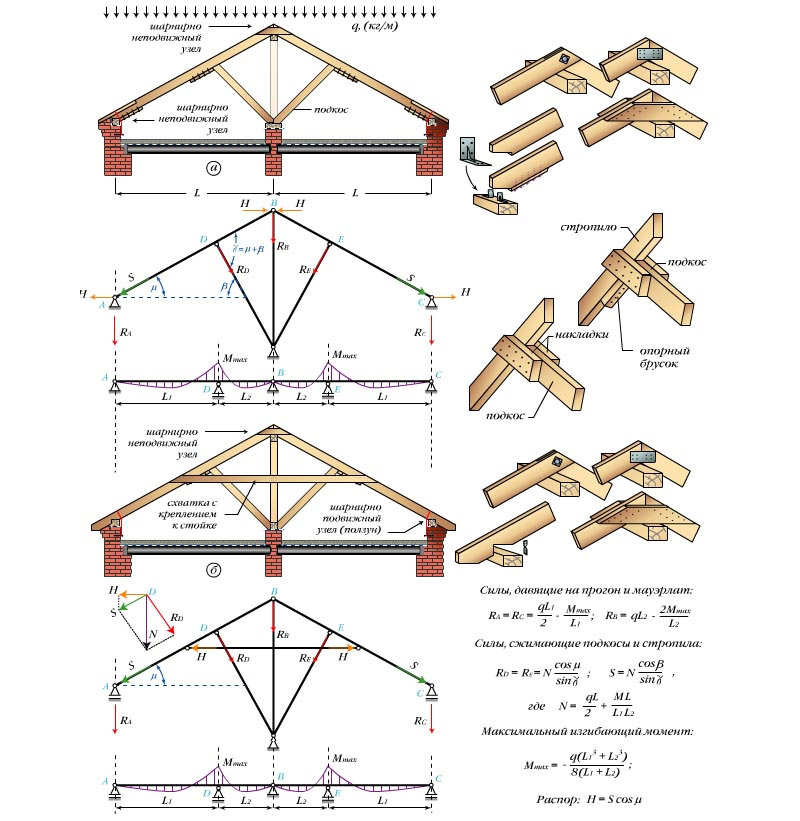
#4. Rafters on rafters.
If there are two load-bearing walls in the house, two sub-rafter structures are used. They consist of beams laid along the long side of the roof. Under them are installed racks on which beams lie. Also, support for them are the bed and the inner walls of the house. If there are no runs, put racks under each rafter foot. The upper parts of the rafter legs are joined one to another and are tied with steel or wooden plates. There is no ridge run, so a spacer appears.
The puff is set lower than the end-to-end runs - this is canceled in an uncontrolled strut system. Fights are attached to the bottom of the uprights for stability. A grapple that acts as a crossbar takes on compression loads. She does not allow the racks to tip over. Stitching attach crosswise.


